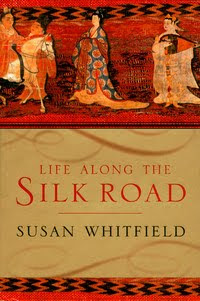 A bit of a gimmick that almost works perfectly. Taking the form of a series of biographical vignettes, Whitfield presents a wealth of information about Central Asian culture and politics between the years 700 and 1000 CE. The diverse points of view bring to light the less-well known aspects of this particular time and place. The first chapter is the Merchant’s Tale and this is perhaps the best place to start because the Silk Road is most famous as a commercial highway. However, Central Asia was also a place of conflict (the Soldier, the Horseman), skillful political and legal machinations (the Princess, the Widow, the Official), religious fervor (the Monk, the Nun), and cultural flowering (the Artist, the Courtesan). Much of the stories told by Whitfield are true. The paper ephemera of administration and letter-writing recorded glimpses of these ancient lives. The paper was then re-used for religious purposes and stored away in vaults full of sacred scrolls. The cool, dry climate has preserved all of it for modern scholars to sift through and bring to us. And yet it doesn’t quite all come off perfectly. The characters are in no way fully-realized and compelling all on their own so those seeking something more like historical fiction will be disappointed. For the more scholarly-inclined, the jumps in time and place and all the asides about politics, cosmetics, geography and animal husbandry make the book feel rather unfocused. It is a window into that world, but not a history, that is, no over-all meaning is assigned to the events related in the tales. In trying to bridge the gap between the scholarly and the popular literature I think this book succeeds but makes for a rickety river crossing.
A bit of a gimmick that almost works perfectly. Taking the form of a series of biographical vignettes, Whitfield presents a wealth of information about Central Asian culture and politics between the years 700 and 1000 CE. The diverse points of view bring to light the less-well known aspects of this particular time and place. The first chapter is the Merchant’s Tale and this is perhaps the best place to start because the Silk Road is most famous as a commercial highway. However, Central Asia was also a place of conflict (the Soldier, the Horseman), skillful political and legal machinations (the Princess, the Widow, the Official), religious fervor (the Monk, the Nun), and cultural flowering (the Artist, the Courtesan). Much of the stories told by Whitfield are true. The paper ephemera of administration and letter-writing recorded glimpses of these ancient lives. The paper was then re-used for religious purposes and stored away in vaults full of sacred scrolls. The cool, dry climate has preserved all of it for modern scholars to sift through and bring to us. And yet it doesn’t quite all come off perfectly. The characters are in no way fully-realized and compelling all on their own so those seeking something more like historical fiction will be disappointed. For the more scholarly-inclined, the jumps in time and place and all the asides about politics, cosmetics, geography and animal husbandry make the book feel rather unfocused. It is a window into that world, but not a history, that is, no over-all meaning is assigned to the events related in the tales. In trying to bridge the gap between the scholarly and the popular literature I think this book succeeds but makes for a rickety river crossing.
High Altitude Cooking Instructions
1 day ago


No comments:
Post a Comment